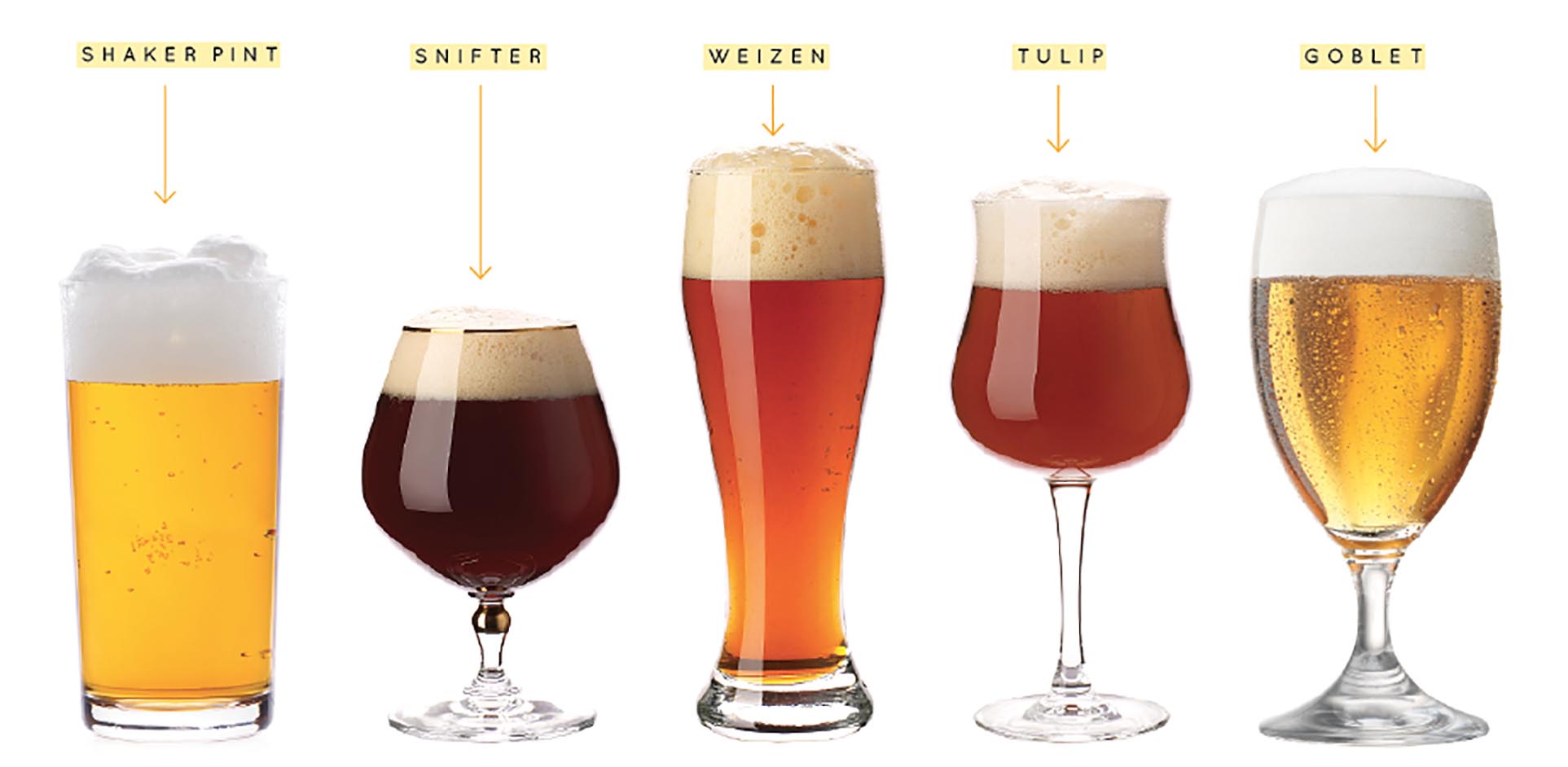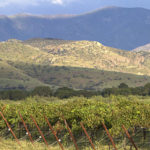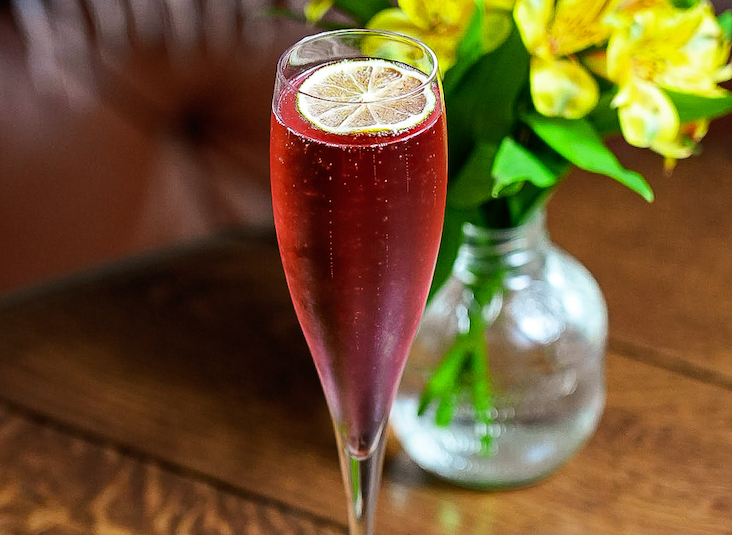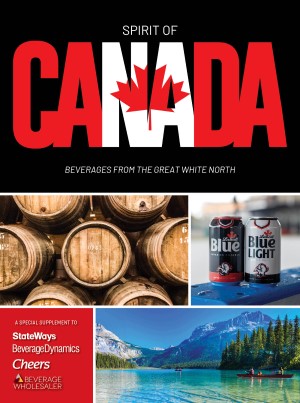What’s in your glass?
If it’s draft beer, chances are you’re holding a shaker pint. Most people know the shaker pint as an affordable conveyance for drinking beer quickly. Yet the straight sides and thick walls of the shaker glass do little for the brew presentation.
“Even though it’s affordable, the shaker pint glass doesn’t flatter many beer styles, because it loses temperature and aromatics quickly,” says Matt Simpson, the Atlanta-based “Beer Sommelier,” who consults and trains bar owners on the promotion and sale of craft beer. “A shallow-lipped tulip glass or 10-oz. snifter with a base wide enough to hold without touching the bowl will let you capture the beer’s color, carbonation and aromatics while still maintaining temperature,” he says.
More craft beer bars now offer choices such as the goblet or chalice, the tulip, snifter and stemmed glassware. It’s all part of enhancing the appreciation of beer, presented to best display the style and flavors.
“If you’re offering a craft beer selection that’s varied and complex, then you’ll want to serve those select beers with appropriate glassware,” Simpson says.
On-premise, draft beer is available in hundreds of different styles at different strengths, so serving a responsibly sized portion makes good business sense.
“People who are going out to enjoy craft beer really take the guest experience seriously,” says Matthew Rutkowski, vice president of Spiegelau Glassware, a subsidiary of Riedel Crystal. “The experience on-premise must meet or exceed the customer’s experience at home. So craft-beer aficionados now seek quality glassware that’s appropriate to the beer style.”
Go for logos
When Simpson is asked to consult on a beer program, “I ask the operator about budget and resources,” he says. “Sometimes, it’s possible to rely on the glassware programs of the local wholesalers and branded options from breweries.”
That’s the path taken by the Tavern Restaurant Group of Cincinnati, OH, says chief operations officer Scott Schmidt. “But proper beer glassware hasn’t been driven exclusively by the American craft beer movement, as we’ve always served imported beer in its own branded glassware.”
Based on the format of a traditional English tavern, Tavern Restaurant Group’s 12 Pub units present draft beer in 2/3 pints, schooners, half-pints (10 oz.) and true imperial pints of 20 oz. “The Pub’s glassware delivers the beer and has the shape and logo as the brewery wants it displayed, so we have more than 30 different kinds of glassware to correspond to the draft list,” says Schmidt.
If you have to buy glassware, Simpson says, “it’s possible to invest less than $1,000 to get an assortment of tulip snifters, stemmed goblets or chalices, IPA glasses and tasting glassware for flights.” He recommends investing in logo glassware to sell as souvenirs for the visitor experience, in a design that is attractive and memorable, conveying the character of the bar or restaurant.
At Mandalay Bay Casino and Resort in Las Vegas, food and beverage operations director Sarah M. Johnson prefers the versatility of the Spiegelau tulip beer glassware. Why?
“It elevates the status of the beer in the consumer’s eyes and makes a better presentation for the beer, as you’re able to swirl around the beer to get the aromas without transferring heat from your hands,” says Johnson.
What’s more, “we find that the tulip glass can be adapted for specialty cocktails, as well the higher end beers,” she says. “If I’m going to a glass without a stem, then I prefer the stemless Riedel glasses, as those are fun and we can use them for cocktails as well.”
The IPA is the reigning beer style in the casinos, Johnson adds, “but we haven’t moved toward using a glass designed just for the IPA style.
Sticky fingers
Beer trends focus on styles, and more often, beer glassware that is designed specifically for that style. “Depending on the scope of service, we recommend presenting beer in the appropriate glass for each major style category, such as IPA, stout, wheat and a ‘all-around’ tulip glass to support strong and Belgian ales,” says Rutkowski.

Cincinnati, OH-based Tavern Restaurant Group, which operates 12 pubs, finds that guests tend to walk off with the branded beer glasses.
From an operator’s perspective, that’s an investment that can be tricky to protect. “It’s always a peripheral concern,” says Tavern Restaurant Group’s Schmidt, “as a specialty beer glass can be so attractive—to the point that some people walk off with them.”
The biggest challenge for the company, he says, “is the keeping them in stock, as some people love souvenirs, so we offer many of the branded glasses for sale.”
Most of the limited-release beers that demand specialty glassware are featured at events such as beer dinners and festivals at Mandalay Bay. A recent beach-themed event called for a beer glass designed to withstand breakage.
“We wound up using stainless-steel pints, because it was a night event, so looking at the beer color wasn’t a huge issue,” Johnson says. “The bigger issue was safety, as everyone was served poolside, so we made the pint into a giveaway with the ticket,” says Johnson.
Beer prices at Mandalay Bay start at $7 for standard 12-oz. craft selections and specialty releases and go up to $35 for large-format bottles.
Unique pours
There are more opportunities for tasting flights with draft beer, Johnson says, but finding the right glassware can pose problems. “Some of the challenge lies in that it is difficult to miniaturize a glass and get the same drinking experience,” she notes. “You also need enough headspace in the glass so that the beer looks full, and the guest can perceive the foam and all the aromas.”
Cordials glasses, such as 5.5-oz. mini snifters, can also be repurposed as beer tasting glasses, Simpson says. “The standard sample pour is about 3 ounces, so this glass design leaves an ounce or so to swirl and get the crown of foam,” he notes. “The curved lip turns inward to focus and collect aromas, making it easy to smell and savor.”
A “pour-your-own-beer” wall, featuring 15 to 20 taps designed for self-service, offers more opportunity for specialty glassware. “We have been using the pour-your-own-beer walls in several of our units,” says Schmidt. “It’s getting a lot of customer attention.” How do they work? Guests show IDs to a server and purchase an RFID card that unlocks the taps to pour the beer, from 1 oz. up to a full glass.
Schmidt says that pricing is comparable to bar service, at 29 to 39 cents per oz., featuring more of the standard draft selections. “We don’t put our bourbon-barrel-aged brown ale on the beer wall,” he says, “because high-gravity beers and limited releases should be poured by the bartenders.”
Tavern Restaurant Group’s beer prices vary by location, from $4 for a 20-oz. Bud Light up to $13.95 for 10 oz. of the limited-release or specialty beers, such as Dogfish Head 120 Minute IPA.
Enhancing the beer experience
Given the increasing price points for craft beer and imports, more people are prepared to invest in proper glassware. “We want to take the guest experience seriously and help present beer for maximum enjoyment,” says Rutkowski.

Mandalay Bay Casino and Resort in Las Vegas prefers the versatility of the tulip beer glassware, which can also be used for cocktails.
The 2014 release of a specialty stout glass designed with Rogue Ales and Left Hand Brewing Co. is an example of such focused design. The Spiegelau Stout Glass accentuates the roasted malt, rich coffee and chocolate notes that define the stout beer style, while maintaining the functional design characteristics of clarity and style.
Guided tastings at the Craft Brewers Conference have helped with industry feedback. “We have found there’s a domino effect in taking the glassware to the industry for testing and feedback, so that each new release is a glass designed by brewers for their beers,” Rutkowski says.
Libbey Glassware has also worked with brewers on custom designs, such as a tall, tapered glass with a footed fingerhold at the stem base, designed for the New Glarus Brewing Co.’s Spotted Cow beer by brewery president Deborah Carey.
While specialty glassware can enhance beer service and enjoyment, many on-premise stuggle with storing all the glasses. It’s hard to find display shelving, storage under the bar or positioned conveniently near the taps. Rutkowski recommends looking at memorabilia and spirits displays first.
“Most of the time you will find at least some poorly utilized space behind the bar, cluttered with random liquors that don’t sell and whatnot,” says Rutkowski. “When cleaned up and used to store glassware to support a serious beer program, the area becomes a profit center rather than wasted space.”
Proper glassware is part of the Tavern Restaurant Group’s success. “We opened four new locations last year, and our average unit volume is $4 million in sales, split evenly between food and beverage, and fully 50 percent of beverage sales in draft beer,” says Schmidt.
Considering that each restaurant location averages more than $1 million in sales in draft beer, he says, “we definitely pay attention to our beer glassware.”
Cleanliness Counts
Beer-ready glassware should sparkle, so many bars and restaurants use a spray rinser to remove any traces of soap, dust or sanitizer before serving. “Demand for rinsers continues to increase,” says Tom Geordt, technical director for Micro Matic USA, a provider of draft beer dispensing equipment. “I would say probably 70% of the draft beer systems we sell include a tray with a rinser.”

Mandalay Bay recently used branded, stainless-steel pint glasses for an outdoor beach-themed beer party and made the glass a giveaway with the event ticket.
What do these cost? A typical tray with a rinser is priced at about $100 more than a standard tray. But there are some additional parts required, Geordt notes. “A water regulator must be included to control water pressure to the rinser, and a backflow preventer is also required.” You’ll also need to install a water shutoff valve, he adds. With the additional equipment and installation required, a tray with a rinser typically requires a $300 investment.
Lucy Saunders is a freelance writer based in Milwaukee, WI, and author of five cookbooks, including Dinner In The Beer Garden.









I love beer. It is a pleasure to go to a place where you can find different types of glassware. It is definitely best to have a drink in the correct glass. I enjoy it